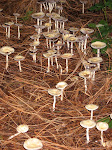 When you think of the classic tom turkey running around in the wild, you might envision something that looks like those brown and orange tissue paper, Hallmark centerpieces that grandma set out annually. You imagine a brisk fall day, with vibrant leaves crunching under foot and a bird that is in full, puffed up regalia. Just add cornucopia, pilgrims and gourds.
When you think of the classic tom turkey running around in the wild, you might envision something that looks like those brown and orange tissue paper, Hallmark centerpieces that grandma set out annually. You imagine a brisk fall day, with vibrant leaves crunching under foot and a bird that is in full, puffed up regalia. Just add cornucopia, pilgrims and gourds.Well, sorry to dash your long held icon of autumnal bliss! Around here, tom turkeys are barely to be found in November, and when they are, they’re scrappy, lean birds.
All their splendid costume can be seen now. Yes, springtime is mating season and the toms look like they’re on steroids. They strut, gobble, turn red and blue (legs and snood), fan out their tails and drape their wings all in hopes of attracting a harem of hens.
Often, several gobblers will present their show in unison, like Radio City Rockettes, without fighting or antagonizing each other. Their focus is on the seemingly aloof hens. Apparently, the male pecking order is worked out in advance.
Once the hens hatch their clutch, they ban together to raise the poults. The crash (a group of turkeys) stays together during the spring and summer months, while the toms generally go solo.
A funny sight is when turkeys prepare to roost for the evening. Around dusk, the crash will quickly trot, one by one, lifting off into flight. Even though they’re a large bird, they fly quite well once off the ground and gracefully glide through the trees. At ShadowWoods, they fly into the pines, first landing on lower branches, and then hopping up the tree until they’re high off the ground safe from nighttime predators. They're less graceful during the hopping stage...
(Photo: Three toms near North Road)




No comments:
Post a Comment
Thanks for sharing...